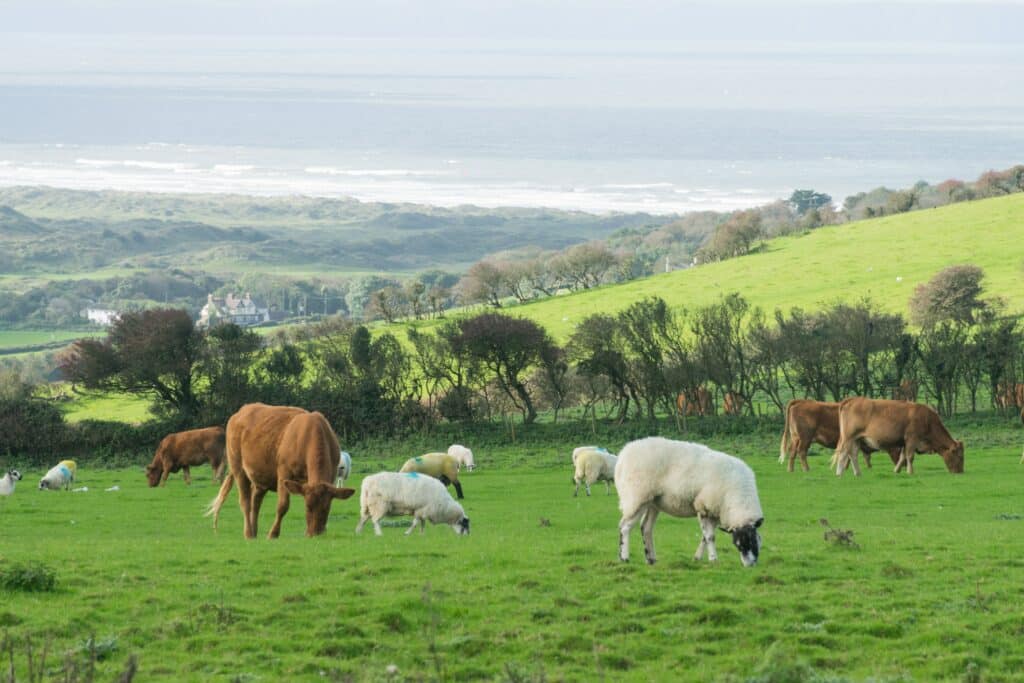The red meat sector faces many challenges, among them are consumer demands for sustainability and eating quality. In the face of this, some in the red meat sector are questioning if the EUROP grading scheme is still relevant. We take a look at the system and what an alternative might look like.
What is the EUROP grading system and what is its history?
Established in the 1980s, the EUROP Grid is used for grading cattle and lamb carcasses in the UK, enforced by EU legislation. It is a prediction of meat yield, estimating conformations and fat class using an E-P scale for confirmation, and a 1-5 scale for fat class.

The classes U, O and P are also subdivided to give a high (+) or low (–) classification, and fat classes 4 and 5 are subdivided into low (L) and high (H). Overall, there are a total of 56 different carcase classifications. There is the greatest demand and higher prices for animals that fall within the green-shaded area. (image from AHDB).
Carcase classification systems are important to ensure fair payment for producers, and to understand what is happening in the market. However, many now believe that the EUROP system is insufficient in meeting consumer demands. After all, it does not consider eating quality, as well as some other factors.
Is the EUROP system still relevant?
The EUROP system does not consider eating quality, or measurements around sustainability. It has, for example, been shown that better-conformed carcases have lower intramuscular fat content, higher shear force values (which impact tenderness) and lower juiciness scores.
A major European study of French, Polish and Irish consumers evaluated steak eating quality. The study suggests there is a negative relationship between juiciness and European conformation score. It says the European carcase classification system may indicate yield. However, it has no consistent relationship with sensory scores at a carcase level that is suitable for use in a commercial system.
European conformation and fat grades are major factors in determining carcase value throughout Europe. However, research suggests that the EUROP grading systems may provide limited information. Therefore, what incentive is there for farmers to drive improvements in eating quality?
What would be the benefits of replacing EUROP?
As the United Kingdom is no longer in the EU and the European Single Market, is there an opportunity to position the UK at the forefront of new metrics? For example, to replace it with something that rewards farmers for feeding and breeding animals to better meet consumer and sustainability needs.
Better Returns
Consumer research on the willingness to pay for eating quality shows that consumers will pay higher prices for better eating quality grades. Future grading schemes which measure both carcase yield and eating quality could help encourage and reward farmers for better feeding and breeding.
More Sustainable Production Systems
A new UK system assessing eating quality might help UK farmers better meet consumer demands over imported products and provide an important competitive advantage. A change of emphasis towards eating quality may also encourage more use of traditional British breeds. It can also encourage more environmentally friendly methods of farming.
Studies show that traditional UK breeds reared on unimproved pasture produced beef of a “high nutritional value” and taste. The trial, supported by the Rare Breeds Survival Trust, Traditional Breeds Meat Marketing and Natural England, studied unimproved pastures containing 40-60 plant species compared with 14-30 species usually found in improved grazing. There were 157 cattle involved and 100 carcasses were used in the final analysis. In the “blind” tasting trial there was a clear preference for beef produced from traditional breeds reared on biodiverse pasture compared with beef from younger, continental crosses reared intensively.
What could replace EUROP and how could it work to promote meat-eating quality and sustainability?
There are examples from outside Europe of carcase grading systems which consider eating quality. For example, the United States Department of Agriculture system evaluates both yield and quality, with a marbling assessment. However, some point out that a marbling focus is not relevant in the UK market, due to its more health-focused consumers. It has also been suggested that water-holding capacity and shear force can be used in addition to EUROP scores.
Other factors related to healthy eating is another option for consideration. Traditional breeds reared on pastures with a rich biodiversity of plants and grasses have lower levels of saturated fat. They also contain more antioxidants than beef produced by cattle reared intensively.
In addition, given UK agriculture’s commitment to Net Zero emissions, why not include environmental indicators? For example, measures of efficiency such as animal age, growth rates, and methane emissions.
Are there drawbacks to replacing EUROP?
The UK continues to export to the EU, and any changes would need to consider the impact on trade. In addition, Northern Ireland currently remains within the European Single Market. Any change needs to consider the impact on cross-Irish Sea Trade. Of course, the EUROP system is well-established and well-understood throughout the supply chain. It would be some time before buyers became accustomed to the new gradings.
Conclusion
A revised carcase grading system could help farmers meet consumer expectations for improved eating quality as well as sustainability. However, there are downsides and practical difficulties to changing the system, including who owns the system.
AgriWebb
Want to see what metrics AgriWebb can help you cover? Look at our features pages here.



 Australia
Australia
 New Zealand
New Zealand
 South Africa
South Africa
 United Kingdom
United Kingdom
 United States
United States